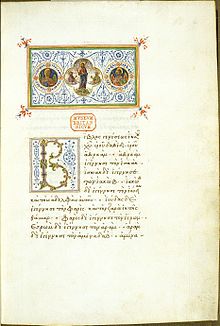Minuscule 448
| New Testament manuscript | |
 Folio 4, beginning of the Gospel of Matthew | |
| Text | Gospels † |
|---|---|
| Date | 1478 |
| Script | Greek |
| Now at | British Library |
| Size | 31.2 cm by 21.5 cm |
| Type | Byzantine text-type |
| Category | V |
| Note | marginalia |
Minuscule 448 (in the Gregory-Aland numbering), ε 509 (in the Soden numbering),[1] is a Greek minuscule manuscript of the New Testament, on parchment. It is dated by a colophon to the year 1478.[2] It has marginalia.
Description
The codex contains a complete text of the four Gospels on 299 parchment leaves (31.2 cm by 21.5 cm). The text is written in one column per page, in 22 lines per page.[2]
The text is divided according to the κεφαλαια (chapters) whose numerals are given at the margin, and the τιτλοι (titles of chapters) at the top of the pages.[3]
It contains lists of the κεφαλαια (tables of contents) before each Gospel, subscriptions at the end of each Gospel, and very beautiful pictures.[3][4] It is clearly but unskilfully written.[4]
Text
The Greek text of the codex is a representative of the Byzantine text-type. Hermann von Soden classified it to the Antiocheian (i.e. Byzantine) commentated text.[5] Aland placed it in Category V.[6] According to the Claremont Profile Method it represents the textual family Kx in Luke 1 and Luke 20. It belongs also to the textual cluster 183. In Luke 10 no profile was made.[5]
History
According to the colophon it was written in Rome, April 25, 1478 by Joannes Rhosos of Crete for Francis Gonzaga Cardinal of St. Maria Nuova. There is a note that Rhosos also wrote the Vatican Homer in 1477 for Cardinal Gonazaga. Then it belonged to Giovanni Pietro Arrivabene.[4] Nathaniel Noel purchased it for the Harleian Library between 20 January between 1721 and 1722.[7]
The manuscript was added to the list of New Testament manuscripts by Scholz (1794–1852).[8] It was examined by Scholz (only Mark 5). C. R. Gregory saw it in 1883.[3]
It is currently housed at the British Library (Harley 5790) in London.[2]
See also
References
- ^ Gregory, Caspar René (1908). Die griechischen Handschriften des Neuen Testament. Leipzig: J. C. Hinrichs'sche Buchhandlung. p. 64.
- ^ a b c Aland, K.; M. Welte; B. Köster; K. Junack (1994). Kurzgefasste Liste der griechischen Handschriften des Neues Testaments. Berlin, New York: Walter de Gruyter. p. 74. ISBN 3-11-011986-2.
- ^ a b c Gregory, Caspar René (1900). Textkritik des Neuen Testaments. Vol. 1. Leipzig. p. 191.
{{cite book}}: CS1 maint: location missing publisher (link) - ^ a b c Scrivener, Frederick Henry Ambrose; Edward Miller (1894 (2005 reprint)). A Plain Introduction to the Criticism of the New Testament. Vol. 1 (4 ed.). London: George Bell & Sons. p. 239.
{{cite book}}: Check date values in:|year=(help)CS1 maint: year (link) - ^ a b Wisse, Frederik (1982). The Profile Method for the Classification and Evaluation of Manuscript Evidence, as Applied to the Continuous Greek Text of the Gospel of Luke. Grand Rapids: William B. Eerdmans Publishing Company. p. 60. ISBN 0-8028-1918-4.
- ^ Aland, Kurt; Aland, Barbara (1995). The Text of the New Testament: An Introduction to the Critical Editions and to the Theory and Practice of Modern Textual Criticism. Erroll F. Rhodes (trans.). Grand Rapids: William B. Eerdmans Publishing Company. p. 139. ISBN 978-0-8028-4098-1.
- ^ Harleian 5790 at the British Library
- ^ Scrivener, Frederick Henry Ambrose (2005) [1894]. A Plain Introduction to the Criticism of the New Testament. Vol. 1. London. p. 225.
{{cite book}}: CS1 maint: location missing publisher (link)
Further reading
- Cyril Ernest Wright, Manuscripts of Italian Provenance in the Harleian Collection in the British Museum: Their Sources, Associations and Channels of Acquisition, in Cultural Aspects of the Italian Renaissance. Essays in Honour of Paul Oskar Kristeller, ed. by C. H. Clough (Manchester: Manchester University Press, 1976), pp. 462–84 (p. 474).
- Repertorium der griechischen Kopisten 800-1600, ed. by Ernst Gamillscheg and Dieter Harlfinger, Veröffentlichungen der Kommission für Byzantinistik, 3-1, ed. by Herbert Hunger (Vienna: Österreichischen Akademie der Wissenschaften, 1981- ), I: Handschriften aus Bibliotheken Grossbritanniens, 3 vols, I, no. 178.
External links
- Harleian 5790 at the British Library
